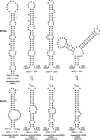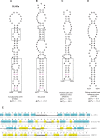Conserved structural RNA domains in regions coding for cleavage site motifs in hemagglutinin genes of influenza viruses
- PMID: 31456885
- PMCID: PMC6704317
- DOI: 10.1093/ve/vez034
Conserved structural RNA domains in regions coding for cleavage site motifs in hemagglutinin genes of influenza viruses
Abstract
The acquisition of a multibasic cleavage site (MBCS) in the hemagglutinin (HA) glycoprotein is the main determinant of the conversion of low pathogenic avian influenza viruses into highly pathogenic strains, facilitating HA cleavage and virus replication in a broader range of host cells. In nature, substitutions or insertions in HA RNA genomic segments that code for multiple basic amino acids have been observed only in the HA genes of two out of sixteen subtypes circulating in birds, H5 and H7. Given the compatibility of MBCS motifs with HA proteins of numerous subtypes, this selectivity was hypothesized to be determined by the existence of specific motifs in HA RNA, in particular structured domains. In H5 and H7 HA RNAs, predictions of such domains have yielded alternative conserved stem-loop structures with the cleavage site codons in the hairpin loops. Here, potential RNA secondary structures were analyzed in the cleavage site regions of HA segments of influenza viruses of different types and subtypes. H5- and H7-like stem-loop structures were found in all known influenza A virus subtypes and in influenza B and C viruses with homology modeling. Nucleotide covariations supported this conservation to be determined by RNA structural constraints that are stronger in the domain-closing bottom stems as compared to apical parts. The structured character of this region in (sub-)types other than H5 and H7 indicates its functional importance beyond the ability to evolve toward an MBCS responsible for a highly pathogenic phenotype.
Keywords: RNA structure; highly pathogenic avian influenza; influenza virus.
Figures






Similar articles
-
Structural Requirements in the Hemagglutinin Cleavage Site-Coding RNA Region for the Generation of Highly Pathogenic Avian Influenza Virus.Pathogens. 2021 Dec 9;10(12):1597. doi: 10.3390/pathogens10121597. Pathogens. 2021. PMID: 34959552 Free PMC article.
-
Hemagglutinin Subtype Specificity and Mechanisms of Highly Pathogenic Avian Influenza Virus Genesis.Viruses. 2022 Jul 19;14(7):1566. doi: 10.3390/v14071566. Viruses. 2022. PMID: 35891546 Free PMC article. Review.
-
Genetic Predisposition To Acquire a Polybasic Cleavage Site for Highly Pathogenic Avian Influenza Virus Hemagglutinin.mBio. 2017 Feb 14;8(1):e02298-16. doi: 10.1128/mBio.02298-16. mBio. 2017. PMID: 28196963 Free PMC article.
-
Phylodynamic study of the conserved RNA structure encompassing the hemagglutinin cleavage site encoding region of H5 and H7 low pathogenic avian influenza viruses.Virus Evol. 2021 Nov 1;7(2):veab093. doi: 10.1093/ve/veab093. eCollection 2021 Sep. Virus Evol. 2021. PMID: 35299790 Free PMC article.
-
[Bird populations--hatching grounds of pandemic influenza viruses?].Berl Munch Tierarztl Wochenschr. 2009 Nov-Dec;122(11-12):440-5. Berl Munch Tierarztl Wochenschr. 2009. PMID: 19999379 Review. German.
Cited by
-
Structural Requirements in the Hemagglutinin Cleavage Site-Coding RNA Region for the Generation of Highly Pathogenic Avian Influenza Virus.Pathogens. 2021 Dec 9;10(12):1597. doi: 10.3390/pathogens10121597. Pathogens. 2021. PMID: 34959552 Free PMC article.
-
Structural and Functional RNA Motifs of SARS-CoV-2 and Influenza A Virus as a Target of Viral Inhibitors.Int J Mol Sci. 2023 Jan 8;24(2):1232. doi: 10.3390/ijms24021232. Int J Mol Sci. 2023. PMID: 36674746 Free PMC article. Review.
-
In silico analysis of local RNA secondary structure in influenza virus A, B and C finds evidence of widespread ordered stability but little evidence of significant covariation.Sci Rep. 2022 Jan 10;12(1):310. doi: 10.1038/s41598-021-03767-x. Sci Rep. 2022. PMID: 35013354 Free PMC article.
-
Hemagglutinin Subtype Specificity and Mechanisms of Highly Pathogenic Avian Influenza Virus Genesis.Viruses. 2022 Jul 19;14(7):1566. doi: 10.3390/v14071566. Viruses. 2022. PMID: 35891546 Free PMC article. Review.
-
Nucleotide sequence as key determinant driving insertions at influenza A virus hemagglutinin cleavage sites.Npj Viruses. 2024 May 13;2(1):17. doi: 10.1038/s44298-024-00029-1. Npj Viruses. 2024. PMID: 40295814 Free PMC article.
References
-
- Abolnik C. (2017) ‘Evolution of H5 Highly Pathogenic Avian Influenza: Sequence Data Indicate Stepwise Changes in the Cleavage Site’, Archives of Virology, 162: 2219–30. - PubMed
-
- Alexander D. J. (2007) ‘An Overview of the Epidemiology of Avian Influenza’, Vaccine, 25: 5637–44. - PubMed
-
- Canale A. S. et al. (2018) ‘Synonymous Mutations at the Beginning of the Influenza A Virus Hemagglutinin Gene Impact Experimental Fitness’, Journal of Molecular Biology, 430: 1098–115. - PubMed
Grants and funding
LinkOut - more resources
Full Text Sources

